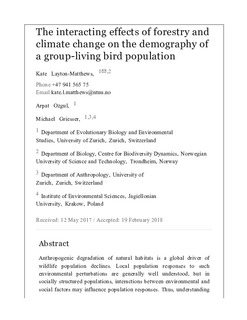| dc.description.abstract | Anthropogenic degradation of natural habitats is a global driver of wildlife population declines. Local population responses to such environmental perturbations are generally well understood, but in socially structured populations, interactions between environmental and social factors may influence population responses. Thus, understanding how habitat degradation affects the dynamics of these populations requires simultaneous consideration of social and environmental mechanisms underlying demographic responses. Here we investigated the effect of habitat degradation through commercial forestry on spatiotemporal dynamics of a group-living bird, the Siberian jay, Perisoreus infaustus, in boreal forests of northern Sweden. We assessed the interacting effects of forestry, climate and population density on stage-specific, seasonal life-history rates and population dynamics, using long-term, individual-based demographic data from 70 territories in natural and managed forests. Stage-specific survival and reproductive rates, and consequently population growth, were lower in managed forests than in natural forests. Population growth was most sensitive to breeder survival and was more sensitive to early dispersing juveniles than those delaying dispersal. Forestry decreased population growth in managed forests by reducing reproductive success and breeder survival. Increased snow depth improved winter survival, and warmer spring temperatures enhanced reproductive success, particularly in natural forests. Population growth was stable in natural forests but it was declining in managed forests, and this difference accelerated under forecasted climate scenarios. Thus, climatic change could exacerbate the rate of forestry-induced population decline through reduced snow cover in our study species, and in other species with similar life-history characteristics and habitat requirements. | nb_NO |
